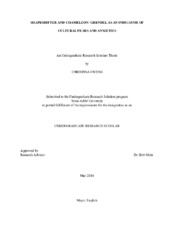| dc.description.abstract | The Anglo-Saxon poem, Beowulf, has seen many revivals and revisals. It has been employed within contemporary society primarily as a form of entertainment, but has also been evoked in the name of political reform and used as evidence of national character and cultural identity. Over time, the familiar characters of the poem have transcended verse and worked their way into music, visual arts, fantasy, sci-fi and steampunk novels, cinema, television, children’s and young adult’s comic books, and even board games. Beowulf falls in and out of vogue, but more often than not, after lying dormant for a duration of time, the poem resurfaces with renewed cultural cachet during particularly traumatic periods. This is especially true when examining the poem’s entanglement with war in Western culture and society. This research will focus on how the terrorist attacks that took place on September 11, 2001 influenced translations and adaptations of the Old English poem Beowulf, specifically the lines, illustrations, and scenes concerning Grendel. In order to establish previous wartime trends I will examine the treatment of Grendel during World War I, World War II, and the Vietnam War. This background analysis creates an accurate and unified vision of how the lethal force of Grendel has been handled by Western translators during wartime, or after culturally traumatic events. These trends will then be compared to several multi-media portrayals of Grendel that surfaced during the years following the destruction of the World Trade Center. I will examine multiple translations from each time period, images of Grendel from children’s and young adult adaptations of the Anglo-Saxon poem, and scenes from Beowulf films and comic books. Dipping into different genres and mediums allows one to draw more accurate conclusions about the figure of Grendel as an entity that lives within various art forms and the American cultural subconscious. Monsters that function as destructive forces of nature in cinema and literature can be indicative of how a culture deals with trauma brought on by warfare, and this project will yield a cohesive image of the ways in which Western mourning practices, coping mechanisms for trauma, and attitudes towards armed conflict have evolved during a timespan of 95 years. | en |


